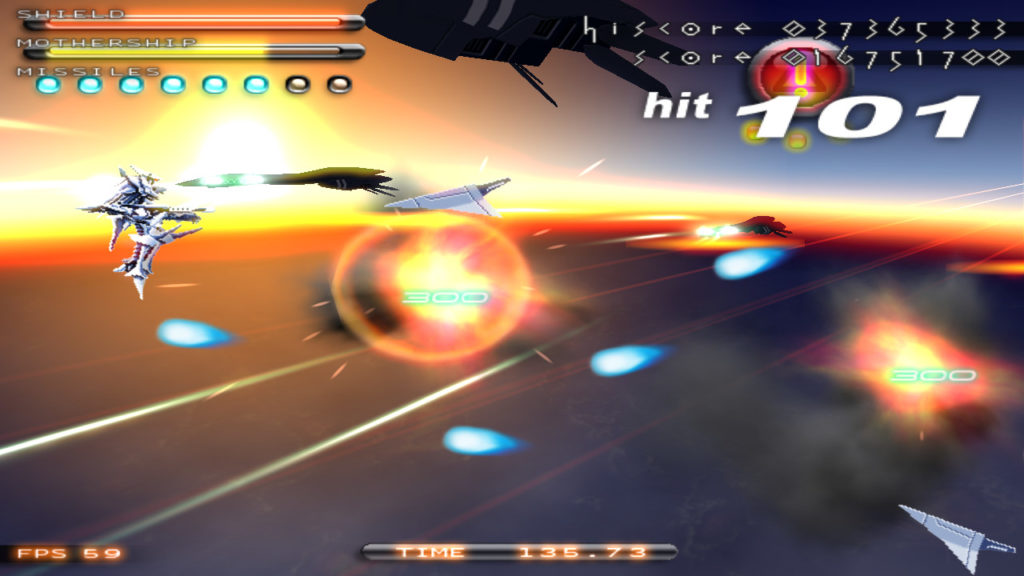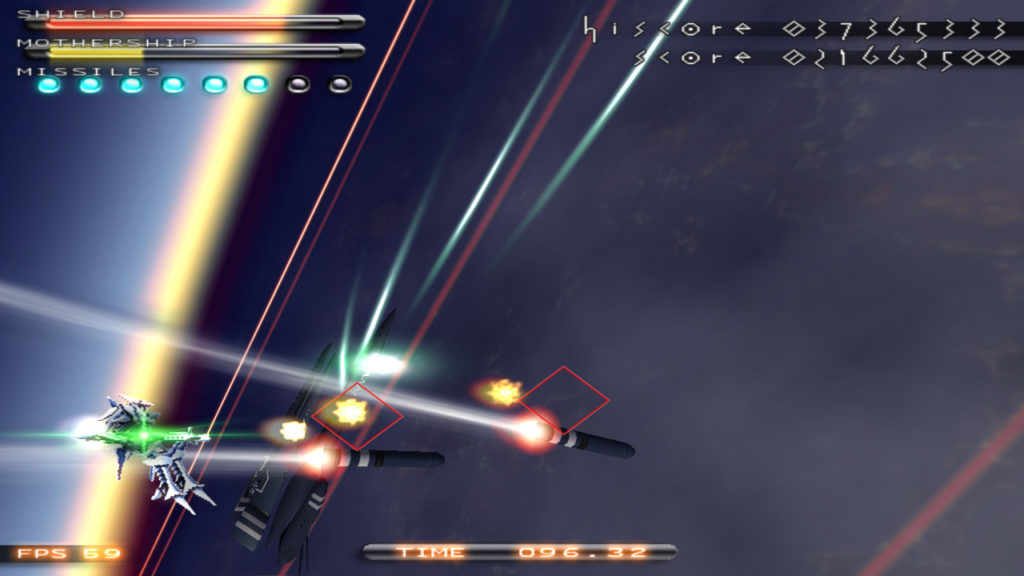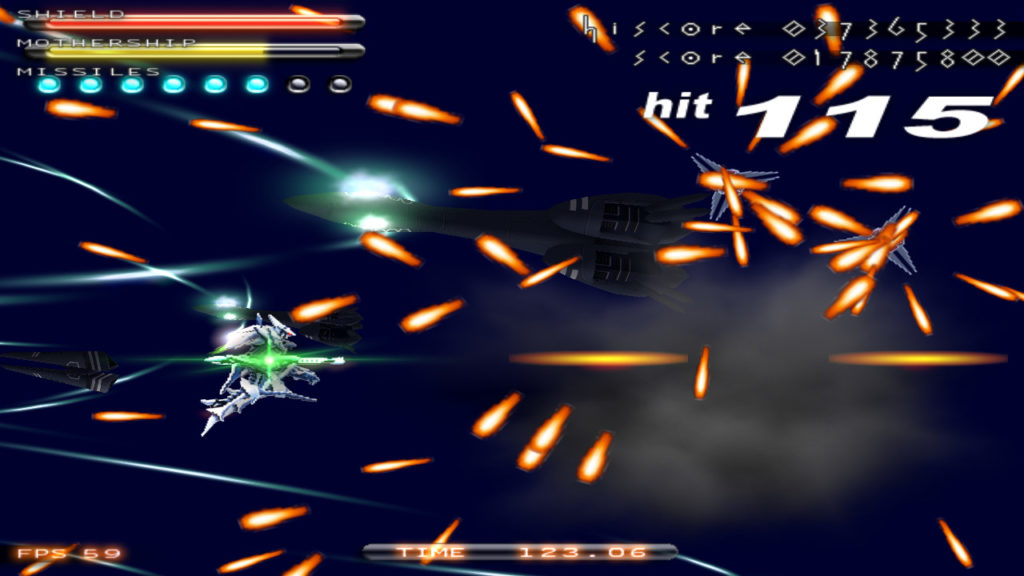Long ago, I stumbled upon the demo for cloudphobia and expected to never be able to access the full game as it was only available in Japan, so seeing an official Steam release for this game was a massive, nostalgia-fueled surprise to say the least. Setting itself apart from every other shmup I can remember, cloudphobia incorporates a strict time limit into each of its levels and players must make use of a speed boost ability to complete each stage before running out of time while also watching their own health as well as the health of the unseen mothership. If you ever thought the shmup genre could benefit from some added complexity, then this is definitely a game you won’t want to pass up!
The timer and the mothership mechanics are the stars of the show here, but let’s first take a quick glance at the abilities available to the protagonist. In cloudphobia you pilot a giant robot (the hitbox is still small though) with two weapons to choose between at the start. These weapons are the PLG-90 Laser Ignition Rifle and the Núllpunktur Vibroblade. Regardless of which weapon you choose, you still start with access to eight homing missile barrages, which are the ‘bombs’ of this game though they do not provide invincibility frames, and the boost mechanic which I’ll hold off on discussing for now, but the primary weapon nevertheless has a massive impact upon how you’ll play the game. The rifle is easily the more standard weapon of the two as it provides a rapid-fire stream of bullets in a straight line. Since this weapon allows players to safely remain near the left side of the screen, away from where most enemies will be pouring in, while also undoubtedly being a familiar weapon to anyone even passingly familiar with shmups, it’s definitely the easier of the two to play through the game with and the most friendly option for new players.

Meanwhile, the sword is an entirely close-range weapon and a more complicated one to use at that. The initial attacks with the sword are two very strong slashes, but continuing to hold down the attack button results in performing a whirling sword spin which rapidly deals small amounts of damage until you let go of the button to sheathe the sword. Thus, you want to use the whirling attack on swarms of smaller enemies while utilizing strings of single slashes on stronger foes. Between its short range and its more complicated mechanics the sword is significantly more difficult to use than the rifle, especially since cloudphobia is far from a cakewalk to begin with. I still can’t use the sword well and I initially dismissed it as being outright inferior to the rifle, but I’ve seen enough replay videos by sword users at this point to safely say that it can be a powerful weapon easily on par with the rifle for those willing to put in the time and effort it takes to master it.
With the basic gameplay out of the way, we can now dive into discussing the mothership and the time limit. Within this game you have four resources, which are time, missiles, your health, and the mothership’s health. Both you and the mothership can take quite a few hits, but if either health bar becomes fully depleted or if you run out of time it’s a Game Over. The mothership is not a physical object within the game itself, so you never need to worry about protecting it from bullets. Instead, any enemy which leaves the screen will deal some damage to the mothership. Small enemies only take away tiny slivers of health so it’s usually not a problem if you miss one or two of them, but taking too long to kill just about anything which doesn’t die in one hit can result in it leaving the screen and taking off a huge chunk of the mothership’s health. Even without the timer, the mothership mechanic forces you to play fairly aggressively as any miniboss which you try to be overly careful with will simply go away and hurt the mothership and letting entire formations of small enemies slip away while focusing on larger threats can lead to all those tiny slivers of damage adding up quickly.

If the mothership results in encouraging more aggressive play, then the timer adds in a more dynamic element. With a limit of exactly three minutes per level, it’s impossible to reach the end and defeat the boss without making use of the boost. This boost comes in the form of a jetpack which greatly increases the speed at which your robot travels through the level, but using this ability carelessly comes with consequences. In addition to increasing the speed at which enemies fire and move at, the boost also influences just where enemies appear on the screen. Warning signs pop up right before enemies appear, but choosing to ignore these warnings while boosting will allow enemies coming in from the top and bottom to start pouring in further to the left and any enemies which stick around for a while will also be pushed left as you outpace them. The sword outshines the gun in these situations as it is has some vertical reach on its attacks, but this otherwise means that large enemies will leave you less room to dodge as you attack them from the left side of the screen and enemies which beeline for the mothership will reach it far faster. Excessive boosting can also lead to quickly becoming overwhelmed as groups of enemies which would normally appear one after the other can begin to overlap, resulting in the screen becoming flooded with multiple swarms of weak enemies or in needing to fend off attacks from enemy swarms in the middle of a fight with a miniboss.
The addition of time pressure also has a significant impact upon how scores are calculated. As shmups normally have a set pace through which players progress through their levels, scores based on time generally either aren’t included or are dependent entirely upon how quickly bosses can be killed. However, you are constantly aware of time in cloudphobia from the moment you start a level and every fraction of a second you spend not boosting results in a few more points being lost. The risk vs reward mechanics behind boosting are further highlighted by the existence of combo kills; flooding the screen with hordes of enemies is dangerous, but it can lead to creating a huge kill chain and the missile attack can go up to a 16x multiplier when it kills enough enemies. Most groups of enemies also include a red unit which is worth significantly more points, so this results in an even more complicated and dynamic metagame for experts looking to reach the top of the leaderboard as using a single missile barrage to take out two or more strong red units with the maximum possible multiplier will make your score skyrocket. Add in an additional bonus for not taking any damage and a grazing mechanic which grants an additional handful of points every time you come close to a hazard without actually touching it and the result is a game which allows for some very flexible strategies when it comes to chasing high scores. However, points are important even for those who simply want to beat the game as the number of points earned in a level determines how much health you and the mothership regain and how many missiles are restored. Getting hit also momentarily stuns you, which often leads to at least a few small enemies slipping away to attack the mothership in addition to temporarily disabling your ability to boost, so playing poorly results in taking more damage and having less points from time to recover that damage with; your performance in early levels can have a real impact on the difficulty of later areas.

The approach to level design is also somewhat different here from other shmups. Between the focus on the levels themselves and the ever-present time limit, there is considerably less focus on the end-of-level boss fights. This isn’t to say that these bosses are pushovers or that they don’t look impressive (the more humanoid robots in particular have great designs), but these are fights which are usually over within about 30 seconds, give or take, rather than multi-phase duels which take up more time than the actual stages; boss fights are fun finales to solid levels rather than the primary focus. On the other hand, minibosses and fights against groups of tougher enemies appear frequently within the levels themselves, so you’re certainly not spending most of your time just killing off weak swarms. There is also a sense of cinematic flare here. Whether you’re fighting in the tight confines of a ship, zooming around a battlefield in the sky, or flying through the flooded remains of a city, the backgrounds are all carefully detailed and give a better sense of movement and place than the generic, repeated blobs of land or the empty skies of most shmups, especially when you rush past the scenery. This is absolutely not a corridor shooter as walls are only a hazard in level four, but the impressive background visuals, dozens of unique enemy movement patterns, and the near-constant presence of strong enemies and outright minibosses combine to make each level memorably unique from both an aesthetic and a gameplay perspective.
With a three minute time limit on each of cloudphobia‘s five levels, a single run through the game can only last exactly 15 minutes at the absolute maximum, making this a rather short game even by shmup standards. The game also falls short in terms of quantity when it comes to customization with only two initial difficulties to choose between and a mere two weapons. Thankfully, cloudphobia counters its lack of quantity by making every level and every choice carry a huge amount of weight. The gun and the sword require incredibly different playstyles to use well and the difficulty options affect everything from which attacks enemies use to how many enemies appear in certain groups and which enemies you even fight; many passageways in level four are completely redesigned on the easier difficulty and several physical obstacles are outright removed. The achievements also hint at the presence of an unlockable Hard Mode, which likely makes as much of an impact upon the difficulty as the leap between Easy and Normal, though I have yet to gain access to this third setting. Add in the ability to replay any level which you’ve beaten at least once, a generally high level of difficulty which means you’re probably not going to reach the end until after a good number of attempts, and the large number of factors which are taken into account when scores are calculated, and the end result is a game which is going to provide far more than 15 minutes of entertainment by the time you’re done with it.